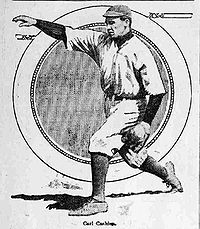His two career highlights consisted of his 1912 season, one in which his Washington Senators team lost out in the pennant chase to the eventual World Series Champion Boston Red Sox. But the team managed by the great Clark Griffith had nothing to be ashamed of, finishing 91-61- still an un-sultry 14 games behind the AL Champs. The big train was the star of the team that season, winning 33 games and RHP Bob Groom won another 24. Ironically, on that same pitching staff was a RHP by the name of Dixie Walker- the father of future Brooklyn Dodgers OF star Dixie Walker and MLB manager Harry Walker. Cashion went 10-6, 3.17 pitching in 26 games and making 17 starts. The 1912 season was clearly the definition of Cashion as a pitcher, as he appeared in just 17 other MLB games, 13 starts, in the 1911, 1913 and 1914 seasons.
Cashion's other claim to fame came on this date 102 year ago. Johnson had pitched the first game of a double header against the Cleveland ballclub. The 4-2 CG victory was the 15 straight win for the Big Train. Cashion was slated to pitch the second game. The flame thrower responded by pitching a 6 inning no hitter, leading the Senators to a 2-0 victory. The only baserunners were off of two errors by the shortstop. The game was shortened, not because of daylight, but because the Naps had to catch the last train to Boston for their next day's game(s).
Cashion would pitch to a 4.72 ERA in the other mentioned 17 games, 13 starts. After his arm gave out, he became a minor league OF, where he hit over .300 from the years of 1914-1918. The following are quotes from both Sporting Life of 1912 and then Baseball Magazine in 1919.
". . . Carl Cashion . . . is perhaps the biggest man in the major leagues, but being all muscle and sinew, without as much flesh on him as a spring chicken, is fast nonetheless, and is something of an athletic phenomenon. This big youngster is a natural batter. He has hit .300 to date . . ." - Sporting Life of May 18, 1912, while Cashion was still primarily a pitcher, after Carl had hit .324 in 1911 in the majors and over .300 that year in the minors.
"Another boxman who had Rusie's speed, but in this instance never gained control, was Carl Cashion, a giant tried out by Griffith a few years ago. Cash had so much stuff that it was hard to follow the pill as it flashed across the plate. The pity is that he was unable to tame it . . ." - Baseball Magazine in 1919.


 RSS Feed
RSS Feed
